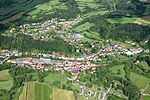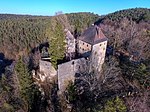Sophie Cave
Caves of GermanyLandforms of BavariaPrehistoric sites in Germany

Sophie's cave is a natural karst cave near Kirchahorn, a district of the Upper Franconia municipality of Ahorntal in the district of Bayreuth in Bavaria. The stalactite cave is located on the northwestern edge of the Ailsbach Valley, not far from Rabenstein Castle in Franconian Switzerland. With its three large sections and winding passages, Sophie Cave is considered one of the most beautiful show caves in Germany.
Excerpt from the Wikipedia article Sophie Cave (License: CC BY-SA 3.0, Authors, Images).Sophie Cave
St 2185, Ahorntal
Geographical coordinates (GPS) Address Nearby Places Show on map
Geographical coordinates (GPS)
| Latitude | Longitude |
|---|---|
| N 49.826944444444 ° | E 11.375833333333 ° |
Address
St 2185
95491 Ahorntal
Bavaria, Germany
Open on Google Maps








